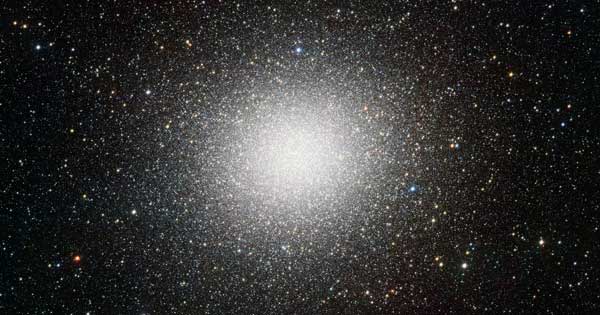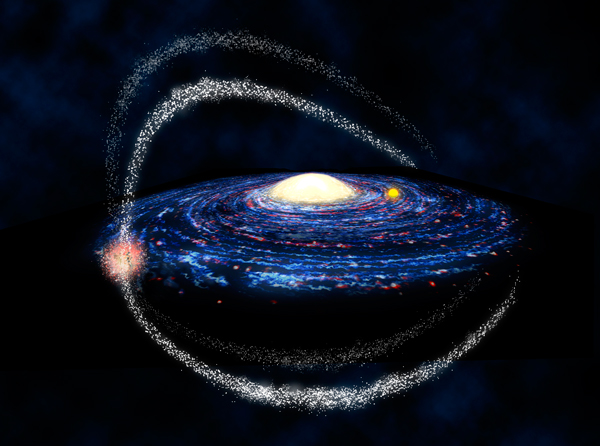Astronomers have discovered a stream of stars pulled from Omega Centauri, the largest and most brilliant globular cluster around the Milky Way — and perhaps a one-time dwarf galaxy.
Around the Milky Way are more than 150 globular clusters, ancient star cities with hundreds of thousands of closely packed denizens. Most such clusters can be found out in the galaxy’s nearly empty halo; it’s likely they formed before our galaxy did. But one of these is not like the others.

ESO / INAF-VST / OmegaCAM; Acknowledgement: A. Grado, L. Limatola / INAF-Capodimonte Observatory
Omega Centauri (NGC 5139, or Omega Cen for short) is unusually brilliant, massive, and huge: 10 million stars squeeze into a sphere about 150 light-years wide. What most puzzles astronomers, though, is that its stars come in at least three distinct populations, suggesting the cluster came together over billions of years instead of all at once.
Astronomers have long thought this peculiar globular might be something else altogether: the remains of a galaxy that came too close to the Milky Way. Torn apart by our galaxy’s gravity, its stars would have streamed into the halo and looped around the galaxy, leaving a small cluster-like core behind.
Now, Rodrigo Ibata (University of Strasbourg, France) and colleagues report new evidence for this theory in Nature Astronomy: the long-sought detection of a stellar stream belonging to Omega Cen.
Researchers have been looking for (and finding) the stellar remains of torn-apart clusters and galaxies ever since the first streams were discovered in the Sloan Digital Sky Survey, but it’s been rough going. “Streams have been hard to detect because they are so low in density and therefore hard to detect visually,” explains Jeremy Webb (University of Toronto), who was not involved in the study. “Most do not stand out visually amongst foreground and background stars.”
(Stellar) Rivers in the Abyss
But with European Space Agency’s Gaia satellite, astronomers can see the distances and precise movements of a billion stars. When stars near each other in space also move together, especially when they lie outside of the galactic disk, it’s a good sign that they’re part of a stream. To find these stellar groupings, Ibata’s team applied a computer algorithm called Streamfinder to sort Gaia’s wealth of data. It picked out more than a dozen new stellar streams that loop around Milky Way’s flat spiral disk.
The team dubbed one of these streams Fimbulthul, named for one of the eleven rivers that coursed through the primordial void in Norse mythology. Its 309 stars span 18 degrees on the sky. The team calculates that the stars’ orbits take them as close as 5,000 light-years to the galactic center and as far as 21,300 light-years, orbital properties that are remarkably similar to those estimated for Omega Cen. And like Omega Cen, the stars of Fimbulthul lack heavier elements, which means they’re similarly ancient. The team conducted computer simulations to show that Fimbulthul could be the trailing arm of stars that our galaxy’s gravity has pulled from Omega Cen.
This discovery isn’t unprecedented: Dozens of stellar streams litter the galaxy’s halo. Although most of the ones found so far come from clusters rather than galaxies, the Milky Way is in the process of tearing the Sagittarius dwarf elliptical galaxy to shreds — its stars stream in a gigantic, almost polar orbit around our galaxy. In fact, Omega Cen may show what Sagittarius will look like billions of years from now.

Amanda Smith / University of Cambridge
The researchers acknowledge that their computer simulations are still very simple and not a perfect match to the data. Their future plans include working on more realistic models to better understand the Fimbulthul stream’s origins and find other stars associated with Omega Cen.
 1
1









Comments
Anthony Barreiro
April 23, 2019 at 2:23 pm
Omega Centauri is the only object I know of that has been classified as a star (by Ptolemy and Johann Bayer), a nebula (by Edmond Halley), a globular cluster (by James Dunlop), and a dwarf galaxy (by Eva Noyola, Karl Gebhardt, and their colleagues).
You must be logged in to post a comment.
You must be logged in to post a comment.